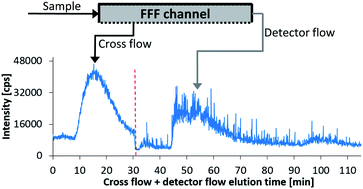A novel approach for determination of the dissolved and the particulate fractions in aqueous samples by flow field flow fractionation via online monitoring of both the cross flow and the detector flow using ICP-MS†
Abstract
Size resolved elemental characterisation of nanoparticles and colloids is routinely performed via flow field flow fractionation online with inductively coupled plasma mass spectrometry (ICP-MS) for a variety of sample matrices. However, low molecular weight elemental species (i.e. the dissolved fraction in the context of this study) pass with the cross flow through the membrane of the separation channel and thus escape detection. The lack of information on the dissolved fraction is a significant disadvantage compared to centrifugal field flow fractionation and chromatographic techniques. This fraction is relevant to determine the ratio of free and particle bound nutrients or toxicologically relevant elemental species, to establish the dissolution rate of non-stabilised (nano)particles and to establish a mass balance for quality control of the fractionation results. Fraction collection of the cross flow followed by off-line elemental analysis is rarely performed to determine the dissolved fraction because of delayed elution through the frit of the channel, dilution and elevated blank levels for some elements. Therefore, a novel approach was developed in this study enabling the online monitoring of the dissolved fraction in the cross flow. A special interface was constructed to convert the discontinuous cross flow into a continuous flow to the ICP-MS. Two frit materials, ceramic and steel, were investigated to overcome the challenges of the interaction of dissolved elemental species with the frit and to improve recovery. Quantification was performed both for aqueous standard solutions and for environmental water samples using ultrafiltration as a reference method. Finally, a combined method including monitoring of the dissolved fraction in the cross flow and the particulate fractions in the detector flow was established. Comparison of the dissolved fraction obtained with the new method and via ultrafiltration indicates the suitability of the developed approach for environmental water samples with mean recoveries in the range of 87% to 120% for Ca, Mg and Si. In the case of Al and P the dissolved fraction is in the low μg L−1 range resulting in partially elevated recoveries but their concentrations match within their confidence intervals.



 Please wait while we load your content...
Please wait while we load your content...